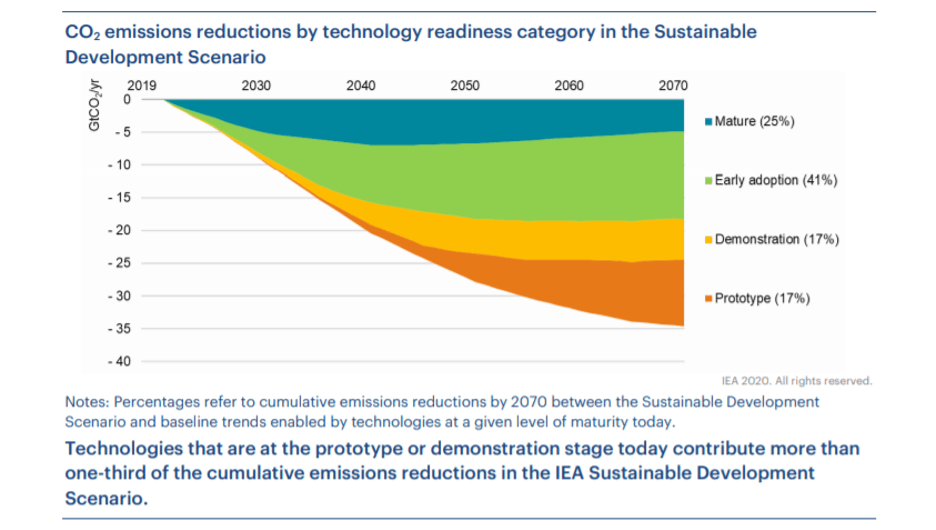It can take a long time for technologies to move from basic research to wide-spread commercial adoption. Solar photovoltaic panels were first developed by Bell Labs in the 1950s, and only in the last decade have policy and technological advancements enabled the cost declines necessary for them to proliferate. Moreover, companies working on new technologies must navigate a period known as the ‘valley of death,’ in which they face the twin challenges of high costs and low investment in their technology. Without government policy intervention, many of these technologies may not mature quickly enough to deploy before it is too late. Investment in R&D can also produce additional public benefits, such as pollution reduction or the advancement of scientific knowledge, that companies cannot fully capture. This makes public investments critical to maximizing the potential of technological innovation.
The U.S. solar industry is a good example of how R&D investment and incentives can drive progress. Relatively recent exponential growth in solar energy is primarily due to federal and state policies, including, investment tax credits, renewable portfolio standards, and the U.S. Department of Energy’s SunShot program. The Energy Policy Act of 2005 established Investment Tax Credits, which let solar installers at the commercial, residential, or utility level get back 30 percent of the costs out of their taxes. At the same time, the Department of Energy’s SunShot Initiative helped the public and private sector collaborate to bring down the costs of solar energy to make it more competitive.
While these efforts have helped the solar industry get off the ground, more legislation will be needed to develop other promising technologies. Fortunately, there are several bills which C2ES has supported that have been introduced in Congress that aim to increase investment for clean energy R&D. The Clean Industrial Technology Act (CITA) is a bipartisan bill targeting industrial emissions which has been introduced in both the House and Senate. It would create an advisory council under the Department of Energy and the Office of Science and Technology Policy to fund R&D to further innovative, emission-reducing technologies. Industry is currently the third-largest source of emissions after transportation and power, but current technologies are insufficient to fully decarbonize the sector. Cleaner industrial process pathways and clean heat alternatives are sorely needed. According to the IEA report, technologies in the demonstration and prototype stage are even more important to emissions reductions in heavy industry and long-distance transport, as those sectors are relatively lacking in options for decarbonization today.
Another bill, the Utilizing Significant Emissions with Innovative Technologies (USE IT) Act, would direct the Environmental Protection Agency to support research on carbon utilization and direct air capture technology, as well as supporting the construction of CCUS facilities and carbon dioxide pipelines. The bill has been passed by the Senate but has not yet passed the House. Carbon capture will be essential in reducing emissions from coal and natural gas plants, not only in the United States, but in developing economies like China and India that rely much more heavily on coal.
Finally, the Nuclear Energy Leadership Act (NELA), introduced by Senator Lisa Murkowski, directs the Secretary of Energy to establish goals for advanced nuclear technologies, establish demonstration projects, and ensure availability of fuel for advanced reactors, among other provisions. As a dispatchable electricity source, nuclear can provide clean backup to intermittent electricity sources. Advanced reactors could be key to achieving full decarbonization of the electricity sector.
In order to help achieve net-zero emissions by mid-century, C2ES launched the Climate Innovation 2050 initiative, which works with dozens of leading companies to identify policy solutions to decarbonize the U.S. economy. Last year, Climate Innovation 2050 released the report Getting to Zero: A U.S. Climate Agenda, which lays out a policy agenda for reaching full decarbonization of the U.S. economy by 2050. The report includes recommendations on encouraging innovation through several approaches, including passing legislation to increase funding for climate-related R&D efforts like the Advanced Research Projects Agency-Energy (ARPA-E), establishing an interagency effort to drive innovation, and working with the private sector to develop a low-carbon innovation agenda. Some of the crucial technologies that the report highlights as priorities are clean electricity, CCUS, energy storage, hydrogen and renewable thermal energy, among others.
We have very little time left to initiate the action needed to fully decarbonize the economy by mid-century. History has shown it can take many years to develop and demonstrate technologies to the point where they are market-ready. That is why it is essential that we invest in R&D for clean energy technologies today, so that we can reap the benefits as soon as possible. While COVID-19 may have been a setback for clean energy, there is opportunity for climate progress if governments prioritize investing in R&D for clean energy innovation as part of economic recovery plans.

